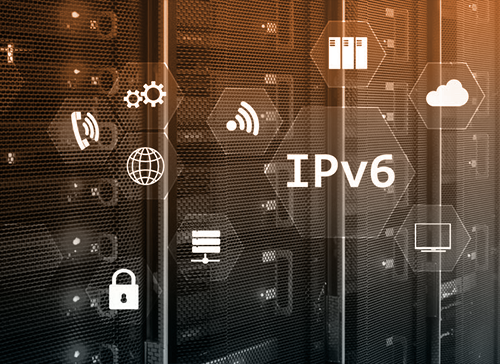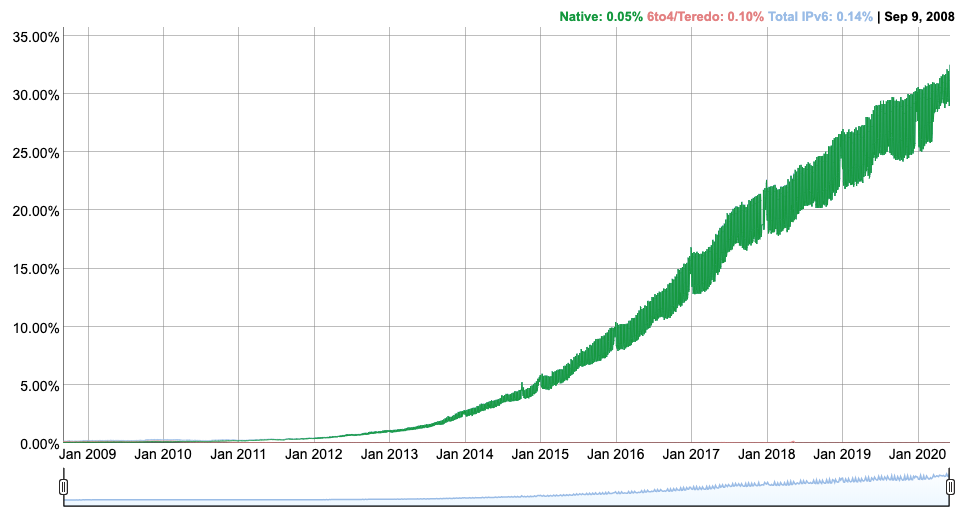
What is IPv6?
Here’s a quick lesson on the history and function of IP addresses. Skip to the next section on Current Adoption Rate if you have basic knowledge about IP addresses.
An IP address, or Internet Protocol address, allows billions of computers, televisions, cell phones, websites, and all other IoT devices connected online to interconnect amongst each other using an address. Think of it like a mailing address that’s required to send someone a letter. An IP address governs online communication by identifying both initiating devices and various Internet destinations, thereby making two-way communication possible.
Currently, IP addresses are in the middle of a decades long transitional phase from the old system in IPv4 to the next generation protocol in IPv6. We can use telephone companies running out of numbers to give customers as an example. IPv4 uses 32-bit addresses, which allows for 4.3 billion unique addresses at a maximum. This seemed fine decades ago, but it’s no longer feasible with the incredible amount of devices that connect to the Internet every day.
In contrast, IPv6 is made up of 128 bits, which equates to a mind-boggling 340 trillion trillion possible addresses. This change will ensure the Internet can continue its current growth rate indefinitely for all sorts of devices.
What is IPv6’s Current Adoption Rate?
Despite the fact that we ran out of IPv4 addresses officially last year, adoption and transition over to IPv6 is still slow. About 30% of the Alexa Top 1000 websites are currently reachable over IPv6. Google shows roughly the same 30% number; here’s the 10 year graph of users that access Google over IPv6 as of June 8, 2020:
At the front lines of IPv6 deployment have been carrier networks and ISPs. National mobile networks especially have very high levels of IPv6 deployment (Verizon: 84%, Sprint: 70%, T-Mobile: 93%, AT&T: 57%).
According to the State of IPv6 deployment by Internet Society, IPv6 has emerged from the “Innovators” and “Early Adoption” stages of deployment, and is now in the “Early Majority” phase.
The Benefits of IPv6
Obviously the most crucial and timely benefit of IPv6 is the abundance of address space. But let’s look beyond that for why else IPv6 is superior:
- Faster – With IPv4, routers have to check packet integrity at each hop. This isn’t necessary with IPv6, so packets are processed quicker for better performance.
- More Secure – IPv4 was never designed to be secure; we fortunately got it right this time around. IPv6 features built-in security, as the packets are encrypted and gets to its destination without being tampered with. Therefore, there’s no packet spoofing attacks that arise with IPv4.
- Multicast – While IPv4 uses broadcast communication, IPv6 uses multicast. Because multicast can send heavy bandwidth traffic to multiple destinations at once, there is less congestion on the local network.
- Smaller Header – IPv6 headers are simplified, with just 5 fields, while IPv4 has 12.
- Plays Nice with IPv4 – IPv6 can coexist with IPv4 during a migration.
The only solution to the problem of address space is IPv6. This is an inevitability. Let’s reference Internet Society’s study again as we echo their thoughts:
Increasingly, IPv4 is an unnecessary cost, and a speculative asset. An IT department or CIO that is faced with purchasing IPv4 addresses has reason to ask whether the expense is worth the value. The short answer is that it increasingly is not. Even when not faced with that decision, the company would do better, in the long term, to sell the address space it has and use the money to fund IPv6 deployment, connecting to an upstream ISP that will use translation mechanisms to connect to remaining IPv4-only content.
The time to start deploying IPv6 is now. You don’t want to be shocked when address space becomes unavailable or a sudden requirement for IPv6 is needed.
Switch to IPv6 with HostDime
HostDime has always been designed with growth and expansion in mind; we implemented our IPv6 network years ago. HostDime clients can leverage our robust and highly redundant IPv6 network, which is 100% native (no tunnels) and dual-stacked (currently supporting simultaneous IPv4 and IPv6). Full IPv6 functionality and redundancy is available at the following HostDime data centers:
- Orlando, Florida
- Los Angeles, California
- São Paulo, Brazil
- João Pessoa, Brazil
- Guadalajara, Mexico
- Bogotá, Colombia
- Kent, United Kingdom
- Rotterdam, Netherlands
- New Delhi, India
The default allocation is a /64 of IPs. Please keep in mind that, for now, IPv6 is a non-SLA service. Configuration fees apply if you would like our assistance in implementation; open a ticket or chat for more information.
[divider]
This article was written by HostDime Marketer Jared Smith.

